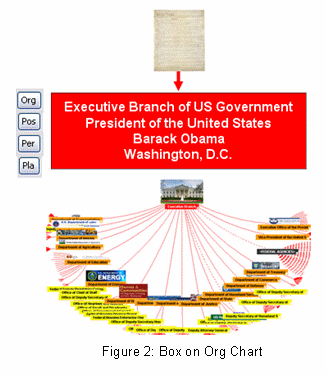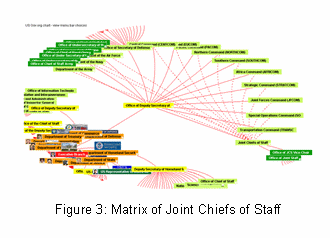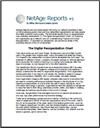They were words you don’t soon forget. “Bureaucracy has committed murder here in the greater New Orleans area,” Aaron Broussard told Meet the Press’s Tim Russert a few weeks after Hurricane Katrina devastated the Gulf coast. The president of Jefferson Parish, Louisiana, Broussard sobbed on national television as he recounted his mother’s drowning in a nursing home because, after five days of promises, no one rescued her or the other residents.
The catastrophic failure of government at all levels that Katrina left in its wake has become the emblem of systemic collapse and functional incompetence. It sharply underscores the need for large-scale reorganization. Poor organization carries great risks: it can lead to poor results, the inability to adapt to change, chronic proneness to instability, and, in some cases, complete collapse.
Good organization designs offer largely untapped resources for productivity that are keys to unlocking performance potential trapped in the structures of our big hierarchy-bureaucracies. At a time when the web is nearly ubiquitous—as is information technology in general—organizations have the capacity to reorganize in ways that lead to their being collectively smarter, better, and faster in meeting challenges and seizing opportunities in the tumult of change.
Done well, reorganization that leverages new forms of network structures is a low-cost, high-yield performance improvement strategy.
Today we’re witnessing a global economic Katrina, unfolding in the continuing news of catastrophic failure of financial organizations around the world. Here in the US, at the epicenter of the crisis, parts of the federal government—such as the Treasury department, the SEC, and the Federal Reserve—are as implicated as public sector institutions—like Fannie Mae and Freddie Mac—as are commercial enterprises—Bear Stearns, Lehman Brothers, AIG, Madoff, and the banks in general, just to name a few.
The collapse of so many institutions at the same time screams out for reorganization, now unavoidable and now underway in all sectors. But before you whip out your organization chart and start crossing off boxes or stripping out layers, you would be well advised to remember this: simplistic reorganization often makes things worse.
After years of study of enterprises in many sectors, with varying missions, and of widely-divergent imperatives, we’ve developed an approach to smart reorganization. We recommend three interrelated actions, each with its own benefits that lead to smart and sustainable reorganization: visualize, analyze, and reorganize, both physically and virtually.
Visualize the Digital Org Chart

To start the process of smart reorganization, first the enterprise needs an accurate picture of itself. Ask anyone in an organization for its org chart and typically you’re handed a piece of paper—or sent to a website—with a box-and-wire diagram showing a few dozen positions. Whether the organization in question has fifty employees or 50,000, the charts generally look the same—and the request for one rarely, if ever, produces an accurate map of the whole thing.
What this means is that the vast majority of people in control are running organizations whose true size, shape, and structure they never really see. Thus, the initial act is to create and maintain an accurate digitized organization chart that represents the entire reporting structure, one that is visible, navigable, and analyzable (see Figure 1, live example). With such a chart in hand, the organization then can:
-
Publish public versions to the web so that anyone can access the map, leading to improved transparency, trust, and cross-organization collaboration;
-
Overlay reporting relationships with additional matrix, team, process, and information connections that intersect positions regardless of who holds them, making for more cohesive, better “networked” organizations and providing greater insight into the complexity of each job;
-
Attach missions, goals, and budgets to each organizational unit, making purposes and resource allocations visible; and
-
Link public data related to each position, including physical location, wiki pages, websites, physical and virtual contact information.
Analyze the Organization as a Network
The next step is to run some basic business intelligence against the comprehensive map of the organization’s reporting structure, using simple tools from the field of network science. Even rudimentary analysis allows the organization to quickly determine the management load of each position, pinpointing which jobs have the most potential for performance improvement and which are at greatest risk for burnout. With these results in hand, management is then in a position to:
-
Better match people to the requirements of each position and understand its impact on the organization as a whole;
-
Design internal communication strategies that allow leaders to reach everyone very quickly with key messages and information, thus avoiding the traditional communication cascade that is prone to message distortion;
-
Craft individual development plans that reflect people’s true leadership responsibilities;
-
Allocate HR and IT resources to support those with the greatest need and potential to contribute to overall organizational improvement;
Reorganize Physically and Virtually to be Smarter, Better, Faster
With an accurate, complete chart of the whole organization and an analysis of the comparative difficulty of each position, the enterprise is in an advantageous position. It can begin to consider reorganization intelligently. We recommend that the organization:
-
Engage discussion about the purposes, roles, relationships that touch each executive, supervisory, and staff position along with their associated organizations;
-
Experiment with different designs to see how the analytic metrics affect communication and decision-making capability; and
-
Use the “reorganized” map to help people understand the changes and gain a view of the organization as a whole, thus enabling them to make better local decisions that fit the global purpose.
Physical Hierarchy, the Topography of Government
Regardless of the organizational design or reorganization strategy, it is important, as we said above, to first establish a realistic depiction of the “physical” organization, to get an accurate chart of its topography. This is the starting point for a “digital organization chart.”
Put on “network glasses” and you can see the hierarchy as just a special case of a network, replete with nodes (positions) and links (relationships). Hierarchy’s role, however, is changing. It increasingly is becoming a framework on which organizations weave a much richer and ever-changing tapestry of working networks.
 A box on a formal organization chart represents a concrete job, the
conjunction of a position and a person. Usually, that job is located
somewhere. If it’s a management job to which other people
report—executive or supervisory—the box also represents
an organization, large or small. For example, Barack Obama ran for
the job of president, a position that leads the Executive Branch of
the US Government, and comes with an Oval Office located in
Washington, D.C. (see Figure 2).
A box on a formal organization chart represents a concrete job, the
conjunction of a position and a person. Usually, that job is located
somewhere. If it’s a management job to which other people
report—executive or supervisory—the box also represents
an organization, large or small. For example, Barack Obama ran for
the job of president, a position that leads the Executive Branch of
the US Government, and comes with an Oval Office located in
Washington, D.C. (see Figure 2).
The basic organizational unit is the position, not the person. These two “node” types, and thus two network types, overlap in the job. Each new cabinet secretary brings his or her own personal, social network to their new jobs. Indeed, their personal networks are primary considerations and qualifications for their positions. They will step into positions that themselves have myriad links to other positions, relationships that would be there regardless of who holds the office.
A position—one job fit for one person—is the concrete, mutually-exclusive smallest unit of the organization. It obeys the organizational equivalent of the Pauli Exclusion Principle in quantum physics, which says, essentially, that two things can’t be in the same place at the same time.
Things are mutually exclusive—and so are people. No matter how many ways a person may be connected and interrelated, he or she is only one entity, one singular human being. Similarly, the position a person holds may be tied to a variety of organizational roles but there is only one HR record of the position, one authorizing paycheck link.
A primary function of hierarchy is to provide the complete classification system for the organization as a whole. Hierarchy makes a place for every job as a category of work and provides everybody a place as a job-holder. These intersecting categories—people, positions, organizations, and places—provide the core nouns for the organizational language, the linguistic medium for internal communication.
Hierarchy also functions as the “end-of-the-day” accountability structure, the responsibility pathways of solid-line leadership making hard decisions. Thus, the hierarchy as a whole is a decision-making network that may perform poorly or well.
As a combined classification-responsibility system, hierarchy forms the organization’s explicit mental model of its internal and external worlds, the basis of its collective intelligence and coordinated action—or lack of it.
Hierarchy has a role, and it is not going away. But its role in the whole structure is radically changing and, in the overall scheme of things, is diminishing because of the rise of other working relationships and organizational structures.
As we look to reorganize, it is critical to see the two types of hierarchy at work, one organizational and one social. Both represent barriers and opportunities in the positional and people networks that cross-hatch the enterprise in every job.
As we look to reorganize, it is critical to see the two types of hierarchy at work, one organizational and one social. Both represent barriers and opportunities in the positional and people networks that cross-hatch the enterprise in every job.
Organizing and Ranking Hierarchies
We often conflate two different types of structure, organizing hierarchies and ranking hierarchies. Organizing hierarchies reflect a cross-domain principle from systems science, while ranking hierarchies reflect social and cultural principles.
The organizing hierarchy is a set of nested parent/child relationships that follow a general principle of physical, biological, and social structure. In abstract systems language, organizations are whole systems that have parts that are wholes themselves composed of parts that are wholes… and so on.
A rank may be related to but is distinctly different from the level of the position held. Rank and level have the same logical formulation, a superior-subordinate relationship, but rank is a social concept. It carries a value judgment, a pecking order, where up is “better than” down, and the higher you are the better you are. Indeed, the word “hierarchy,” meaning “Bishop [hierarch] rule,” was first used around 1880 for ecclesiastical purposes, to establish a ranking system with God at the top with authority flowing down through the Church organization.
Both types of hierarchies exist. People have ranks in social hierarchies while positions have levels in organizational hierarchies.
It is easy to see this difference in the military. There, people have a rank they earn and hold individually, and even carry into retirement. At the same time, over the course of their careers, they rotate through a variety of organizational positions at different levels within the chain of command. Similarly, career government employees carry a civil service ranking, their “pay grade.” Members of the Senior Executive Service carry top civil service grades equivalent to generals and admirals in the military. These are the levels right under the political layers in the federal structure. People carry their pay-grade, while the institution holds the job.
Hierarchy, as a near-universal organizing principle of nature, is here to stay. Hierarchy as a ranking system, however, is really a social and cultural issue. In the 21st century, ranking structures are shaking everywhere. At the roots, quite literally, of so much of the economic disaster lie personal prerogatives of rank taken without regard for organizational responsibility—e.g., inflated CEO salaries for atrocious leadership performance.
Given the complexity and elegance of these aspects of organizational design, we issue this strong warning: Don’t throw out the organizing baby with the ranking bathwater of hierarchy.
Visualize the Networks
Hierarchy is the infrastructure of the networked organization. Each position has a level, an “elevation” in organizational terms. It is equivalent to a physical topography, like an organizational Google Earth. In physical mapping systems, the earth-as-it-is is stitched together at different resolutions corresponding to an “eye altitude.” This enables you to zoom out to the planet as a whole or in to scales of detail down to close to a square meter, about the size of a person standing or sitting. As the planet as a whole is our common root of physical existence, so the root position of an organization encompasses it as a whole, representing the highest eye altitude.
On top of the actual physical topography of the earth, at any altitude, you can add layers of location-related information and associations, whether networks of roads or networks of McDonalds, that you can click on and off in any number of combinations. Government boundaries, how the human world has divided up the earth, quite literally the dirt beneath our feet, come into view then disappear as you fly down from the global view to national, state, and local scales of resolution.
In organizations, network layers reveal additional patterns of real working relationships between the fixed positional units of hierarchy. These include matrix reports, council, committee, task force and team memberships, and process flows. These observable, relatively objective relationships are those that are written down, officially recognized as taking chunks of people’s time, and often associated with budget items. On top of these relationships, there are all the layers of relatively subjective informal and social relationships that connect people to people.
 We
can see a simple example of a network layer at the top of the Defense
Department, the most complex of the cabinet group of org charts (see
Figure 3, the DoD
org charts, and/or run our interactive US
Gov Map). The Office of the Chairman of the Joint
Chiefs of Staff has a few headquarters functions reporting directly
in, then an overlay of matrix reports from the Service Chiefs and
Combatant Commanders whose direct bosses are elsewhere in the Defense
structure.
We
can see a simple example of a network layer at the top of the Defense
Department, the most complex of the cabinet group of org charts (see
Figure 3, the DoD
org charts, and/or run our interactive US
Gov Map). The Office of the Chairman of the Joint
Chiefs of Staff has a few headquarters functions reporting directly
in, then an overlay of matrix reports from the Service Chiefs and
Combatant Commanders whose direct bosses are elsewhere in the Defense
structure.
These overlays serve the purpose of being “virtual reorganizations.” You don’t have to move around boxes or delayer or do anything else that’s hard to do by drawing new lines among existing boxes. Matrix organizations are early, primitive forms of virtual reorganization that make of fixed hierarchies to more adaptable. They are precursors, really, of the 21st century networked organization now emerging.
Dotted-line reports are valuable when used sparingly. Each introduces a natural point of conflict in the accountability function of hierarchies, while improving the “small world” communication function with built-in cross-links. It shortens communication paths from the fixed up-and-down-the-chain hierarchy route between positions. However, when organizations become too heavily matrixed, they risk becoming chaotic and even self-destructive.
Today, non-hierarchical relationships are moving into and between the bureaucratic boxes of specialized functions, creating more flexible, adaptive, and faster results required in the information economy. Formalized process, team, and information relationships are increasingly used to supplement reporting hierarchies. Singular positions are connected by multiple links representing multiple roles within the whole organizational network.
In the Age of the Network, “virtual reorganization” through multiple relationships will become the alternative to and precursor of physical reorganization.
